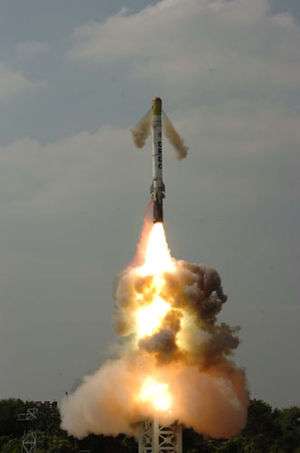Abdul Kalam Island
| Native name: ଅବ୍ଦୁଲ କଲାମ ଦ୍ବୀପ | |
|---|---|
 Abdul Kalam Island Abdul Kalam Island, India | |
| Geography | |
| Location | Bay of Bengal |
| Coordinates | 20°45′29″N 87°05′08″E / 20.75804°N 87.085533°ECoordinates: 20°45′29″N 87°05′08″E / 20.75804°N 87.085533°E |
| Area | 390 acres (160 ha) |
| Length | 2 km (1.2 mi) |
| Administration | |
| State | Odisha |
| District | Bhadrak district |
Abdul Kalam Island, formerly known as Wheeler Island, is an island off the coast of Odisha, India, approximately 150 kilometres (93 mi) from the state capital Bhubaneshwar. The Integrated Test Range missile testing facility is located on the island. The island was originally named after English commandant Lieutenant Wheeler. On 4 September 2015, the island was renamed to honour the late Indian president, APJ Abdul Kalam.[1][2][3]
Geography
Abdul Kalam Island is located in the Bay of Bengal approximately 10 kilometres (6.2 mi) off the eastern coast of India and about 70 kilometres (43 mi) south of Chandipur in Balasore district, Odisha. The island is about 2 kilometres (1.2 mi) in length and 390 acres (1.6 km2) in area.[4] The nearest port is Dhamra Port.
Integrated Test Range
The Integrated Test Range, sometimes referred to as the Interim Test Range, is a missile testing facility composed of two complexes - Launch Complex-IV (LC-IV) located on Abdul Kalam Island and Launch Complex-III (LC-III) located at Chandipur.[5]
The Indian government began searching for a suitable location to construct a dedicated military missile test range and begin development of the Agni series of missile in the early 1980s. The DRDO constructed an interim facility adjacent to the Proof and Experimental Establishment (PXE) at Chandipur. In 1986, the Union Government announced plans to construct a National Test Range at Baliapal in Balasore district, the same district as Chandipur. This would have required the government to move 130,000 people out of 130 villages located in the area.[5]
The Odisha government allotted Abdul Kalam Island to the Defence Research and Development Organisation (DRDO) in 1993, following A.P.J. Abdul Kalam's request for land to build a missile testing facility. Kalam referred to the island as his "Theatre of Action".[6][7] In 1995, the Government abandoned the plan to move the test range from Chandipur to Baliapal, and instead built a new test site known as Launch Complex-IV at Wheeler Island.[5]
Abdul Kalam Island is the missile test facility for most missiles of India; Akash Missiles, Agni Missiles, Astra Missile, BrahMos, Nirbhay, Prahaar Missile, Prithvi Missiles, Shaurya Missile, Advanced Air Defence (AAD), and Prithvi Air Defence. Access to the test facility is by ship, as there is no bridge or airport connecting the island to the mainland. There is a small helipad, but missile airframes and all supplies, construction materials and heavy equipment arrive by ship.[4]
The maiden successful test fire of the Prithvi missile was conducted on Wheeler Island on 30 November 1993. At the time, Wheeler Island was uninhabited.[6][7] Since the construction of the Integrated Test Range, entry to Abdul Kalam Island is restricted for the general public, and only DRDO personnel and Defence Ministry officials are permitted to travel to the island.[8]
Biodiversity
Abdul Kalam Island is located close to the Gahirmatha Marine Sanctuary, the world's largest rookery of the endangered Olive Ridley sea turtles. Abdul Kalam Island's sandy beaches are a favoured nesting location for the turtles. The bright lights installed at the missile testing facility on the island caused some baby turtles to get lost as they were attracted towards the lights. Many baby turtles would fail to find their way to sea, and some died as a result. To protect the turtles, all lights at the facility are dimmed or masked during nesting season, and missile testing is restrained during the turtles' nesting and breeding season.[9][10]
In May 2013, increasing concern has been drawn to the change of the island's topography, owing to sand erosion. Since the island is technically a shoal, seawater frequently causes sand-shifting. The situation is being monitored by geological experts from National Institute of Ocean Technology and the DRDO. [11]
Gallery
-

Advanced Air Defence Launch from Integrated Test Range (ITR), Wheeler Island
-

Akash Missile Launch from Integrated Test Range (ITR), Wheeler Island
-

Shaurya Missile Launch from Integrated Test Range (ITR), Wheeler Island
Abdul Kalam Island launches
See also
- Guided missiles of India
- Indian Ballistic Missile Defence Programme
- Integrated Guided Missile Development Programme
References
- ↑ "In tribute to India's 'Missile Man' APJ Abdul Kalam, Wheeler Island named after him". Zee News.
- ↑ "Kalam Island inspires youth in india. All India youth were proud to be a person lived in this generation for only india". TNP. Hyderabad, India. 5 September 2015.
- ↑ "Wheeler Island renamed after Missile Man". The Times of India. Retrieved 7 September 2015.
- 1 2 "Wheeler Island". Global Security. Retrieved 2014-12-18.
- 1 2 3 "Integrated Test Range". www.nti.org. Retrieved 2 November 2016.
- 1 2 "Odisha's Wheeler Island to be renamed after APJ Abdul Kalam". Hindustan Times. 4 September 2015. Retrieved 2 November 2016.
- 1 2 "Odisha government renames Wheeler Island as Abdul Kalam Island". India Today. Retrieved 2 November 2016.
- ↑ "Two remote cameras stolen from Wheeler Island missile base". Rediff.com. Retrieved 2 November 2016.
- ↑ "How APJ Abdul Kalam helped save Odishas Olive Ridley turtles". India Today. Retrieved 2 November 2016.
- ↑ "'Kalam Island' should be the new name of Wheeler Island". The Economic Times. Retrieved 2 November 2016.
- ↑ "India's lone missile test-firing range Wheeler Island face sand erosion". The Times Of India. 11 May 2013.
